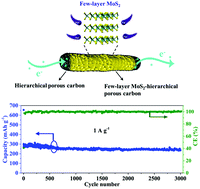An ultra-small few-layer MoS2-hierarchical porous carbon fiber composite obtained via nanocasting synthesis for sodium-ion battery anodes with excellent long-term cycling performance†
Abstract
Rational fabrication of anode electrodes for sodium-ion batteries remains a challenge due to the problem of sluggish Na+ diffusion kinetics, large volume expansion etc. Significant efforts, such as fabricating carbon composites and novel nanostructures, have been devoted to the development of anode materials. Herein, an ultra-small few-layer MoS2 nanostructure confined on a hierarchical porous carbon fiber composite was synthesized through the nanocasting route using a novel hierarchical porous carbon fiber as the template. As an anode material, the composite displays outstanding electrochemical performance for sodium-ion batteries. For instance, it delivers high reversible capacities (491 mA h g−1 after 50 cycles at 0.1 A g−1), high rate performance (387 mA h g−1 at 2 A g−1) and long-term cycling stability (234 mA h g−1 at 1 A g−1 after 3000 cycles). Note that it shows one of the best long-term cycling properties reported to date for MoS2-based anode materials for sodium-ion batteries. This regulation strategy may offer new insights into the fabrication of high-performance anode materials for sodium-ion batteries.



 Please wait while we load your content...
Please wait while we load your content...